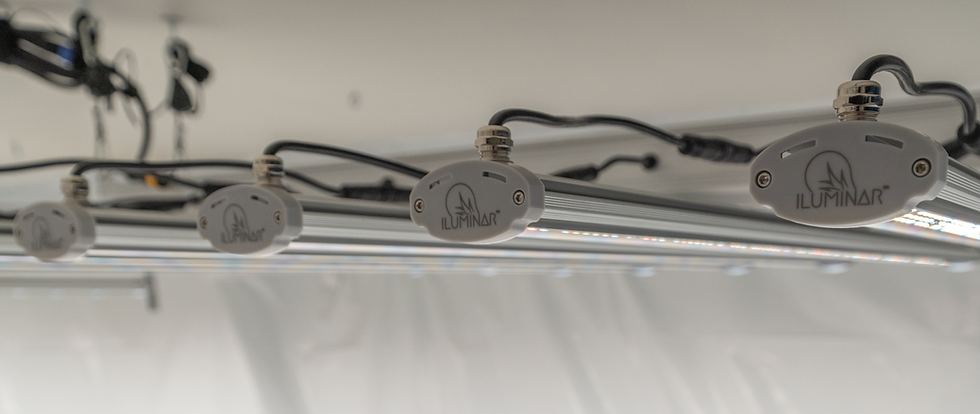Further than PAR—Why ePAR is set to become the new horticultural standard for LED grow lights.
- Shawn Brissette
- May 6, 2021
- 3 min read
Updated: Apr 22, 2022

Indoor growers have enjoyed a long relationship with Photosynthetically Active Radiation (PAR)—the energy that drives photosynthesis.
Ever since Dr. Keith McCree published his famous “McCree curves” (yes, there's more than one!) way back in the '70s, cultivators have accepted PAR as a clear definition of the energy band that drives growth and bloom in plants: 400 to 700 nanometers (nm).
These boundaries represent strict cut off points: if a photon lies just outside this range, say 399 nm or 701 nm, it's historically not been considered as “PAR” and therefore contribute nothing to derived measurements such as Photosynthetic Photon Flux (PPF) or Photosynthetic Photon Flux Density (PPFD).
However...
Did it ever strike you as a somewhat tall coincidence that PAR begins and ends at such neat, round decimal numbers and, furthermore, how exactly it corresponds with the human eye’s visible spectrum? (400 nm is the high energy radiation we see as the color blue / violet and, at the lower energy end of the range, we perceive 700 nm as a deep blood red.)
Well, now it appears that our definition of PAR could be in urgent need of revision.
According to recent scientific evidence from Utah State University’s Crop Physiology Laboratory, plants apparently use a broader range of radiation for photosynthesis and photomorphogenesis than scientists previously thought.
Advanced experimental design and new understandings.
Doctor Bruce Bugbee, a professor at USU’s Department of Plants, Soils and Climate, led groundbreaking research showing plants have the ability to harness a wider range of radiation.
Whereas McCree used a system of prisms and filters to isolate specific wavelengths and study their effect on a single leaf, Bugbee’s research team used advanced LED lighting capable of dimming and altering color ratios.
He also studied wavelength combinations of whole plants, rather than single leaves, more closely mimicking real world and controlled indoor agriculture growing environments.
Photons in both the UV-A (315 - 400 nm) and far-red (700 - 750 nm) bands were shown to contribute to photosynthesis, but only when supplied in tandem with regular PAR photons.
This discovery could have massive implications, both for how photosynthetically active radiation is measured by PAR meters and the optimal spectral output of cutting-edge LED horticultural lighting fixtures in the future.
Introducing "ePAR".
Apogee Instruments, a leading manufacturer of quantum meters, has already released a new family of PAR sensors called “ePAR” based on this updated understanding.
ePAR sensors broaden the existing PAR range by 20 percent; it now starts at the upper end of UV-A (380 nm) and ends just beyond the limit of far-red at 760 nm.
Far-red photons are barely visible to the human eye and, if supplied in isolation, contribute nothing to photosynthesis. However, when combined with other wavelengths, they are equally as important as red photons.
Why is ePAR Important?
This research is still fairly fresh and ongoing; meanwhile LED grow light manufacturers are scrambling to get up to speed by investigating the best ways to incorporate UV-A and far-red diodes into their horticultural lighting fixtures.
During this industry transition, it’s important that consumers don’t unwittingly get left in the “dark ages”.
Using old style PAR meters to measure the output of lighting fixtures with UV and far-red will give a false impression of lower output, compared to fixtures that focus their output in the historical PAR range.
Only by using a new ePAR meter will growers be able to appreciate the full functionality, performance and efficacy of their grow lights.
What’s the big deal with ultraviolet light? Is UV good for plants?
Ultraviolet light (particularly UV-A and some UV-B) is present in incident solar radiation—the sunlight that actually reaches the surface of our planet.
Plant species native to higher altitudes have adapted to cope with higher levels of UV as there is less atmosphere to absorb it.
UV helps to strengthen plants and make them more pest and disease resistant. It can also contribute to the production of essential oils and lead to significantly higher crop quality.
Will far-red light make a positive difference to my crop?
Far-red light, when supplied in conjunction with PAR, has been shown to increase plant biomass and cell expansion.
Not only does it increase the absorption of other wavelengths of light, adding to overall photosynthetic efficiency, but it can also encourage a quicker transition from vegetative growth into generative production (flowering) and enhance the size of flowers.
More questions about ePAR? Feel free to drop us an email at marketing@iluminarlighting.com - we love to chat about our new technology.
Or click here to view our latest iLogic™8 LED that delivers deep, penetrating light intensity along with industry-leading uniformity over a square 4’ x 4’ footprint. Read more...






Comments